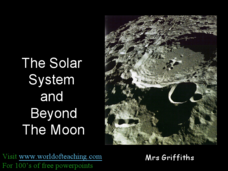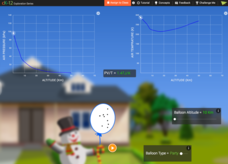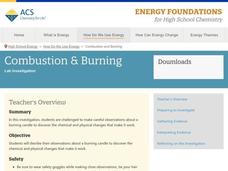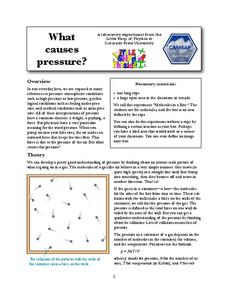Space Awareness
The Sun Compass of the Vikings
Evidence shows the Vikings likely navigated by using a simple sundial to find their course. Videos, a short story, and discussion help bring this time period to life as they study European history with a hands-on experiment. Scholars...
Curated OER
Vanishing Environment: Exploring Changes in Landscape
To discover the impact of urbanization on the environment, learners compare landscape paintings from the past with contemporary photographs, create found poems from descriptions of artwork, design backyard or public garden spaces,...
Curated OER
What Do They Eat?
What does a monkey eat? How about a squirrel? Introduce your young scholars to different types of eaters in the animal kingdom with this cut-and-paste activity. Students assess 6 animals: a squirrel, a frog, a monkey, a seal, a dog, and...
Curated OER
Volume, Mass, and Weight
Study the difference between mass and weight. Your math group will compare the weight of an item to the amount of space that it uses. They'll then use conversion factors to find the difference between kilograms and pounds. Essential...
Curated OER
The Chemical Building Blocks of Life
Amateur biologists examine the macromolecules that are foundational to life: proteins, lipids, and carbohydrates. This worksheet is composed of five pages of questions and plenty of space to write answers. Learners will explore such...
Curated OER
Energy and Metabolism
This four-page worksheet queries young biologists about the process of metabolism in the human body. They describe types of energy, laws of thermodynamics, and chemical reactions related to the processing of energy. Plenty of space is...
Curated OER
Raven Chapter 13 Guided Notes: Patterns of Inheritance
In this short space, it would be impossible to describe the breadth of this seven-page genetics worksheet. Geared toward AP or college biology learners, they explore not only the basic vocabulary and concepts, but also the Law of...
Curated OER
The Solar System and Beyond: The Moon
Here is a very basic look at the moon and its positioning around our planet. The pictures and labels here show different phases and will help your space explorers understand our changing views of the moon along with the Earth's tilt and...
Curated OER
Work and Power Worksheet #1
How much work is done when a force moves a block? How far will power lift a block? And how much work can be done by a motor? These are the kinds of questions you will find on this physics problem solving sheet. With 19 problems to solve,...
Curated OER
3-2-1 Pop!
Pairs of space scientists or junior physicists construct and deploy antacid-powered rockets. Through this activity, they observe Newton's Laws of Motion. The plan is detailed and well-organized. Resource links include professionally...
National Wildlife Federation
What's Your Habitat?
How do human habitats compare to animal habitats? Individuals begin their nature discovery by drawing their own habitats that extend beyond their houses. Pupils ensure their drawings include the four habitat elements of food, water,...
Curated OER
Earth Day Writing
Earth Day is a great topic to write about, and graphic organizers can really help learners classify their thoughts. Here is a fantastic set of themed worksheets that will allow your class to explore and write about conservation. Each...
Random House
Dear Mother Earth
Get those pencils ready because we are going to write a letter to our dear mother, Earth that is. Allow your youngsters to explore and express all the ways that they plan to protect Mother Earth. The worksheet is perfect for Earth Day,...
Armored Penguin
Periodic Table Crossword Puzzle
In terms of crossword puzzles, this one on the periodic table of elements and atomic structure has some value. Twenty questions must be answered to complete the puzzle, but be sure to warn learners that when an answer requires two words,...
Teacher Printables
My Mini Book About …
This is one of several printable pages on which little life scientists can write out their research on an assigned animal. The highlighted page is for alligator research, but several other animal pages are included as other materials....
Curated OER
Mass vs. Weight
Why do you weigh more in space? Each individual in your class explores this question and others as they determine the mass and weight of different objects using two types of scales. They perform conversions and discuss their results,...
PHET
Wave Interference
Why did the waves get into a fight? They were tired of each other's interference. Scholars observe the wave patterns from dripping water, sound waves, and light waves. They vary the spacing, build barriers, and increase the number of...
McGraw Hill
Lunar Phases Interactive
View the moon changes from space while simultaneously experiencing the changes on Earth. A creative lesson allows pupils to view the big picture as they watch the orbit of the moon through a calendar period. At the same time, they see...
McGraw Hill
Gravitational Lensing Interactive
Investigate light in space as it encounters a large mass of matter. Learners discover the idea of gravitational lensing through an interactive activity. They adjust the size and location of the mass to see the effect on the path of...
CK-12 Foundation
Runaway Balloon
When a child lets go of a helium balloon, what happens to it? Does it float all the way to space? The simulator allows pupils to experiment on party balloons and weather balloons under different conditions to see what happens to them in...
American Chemical Society
Combustion and Burning
On Earth, a candle flame points up, but on the International Space Station, it forms a sphere. Young scientists practice their skills by recording observations before, during, and after a candle burns. Chemical and physical changes...
CK-12 Foundation
Journey to Mars
Why are there launch windows when traveling to outer space? Scholars explore the trajectory of traveling from one planet to another. By adjusting the departure and destination planets, as well as the launch date, they observe the ideal...
Cornell University
Celebrate Urban Birds
Set up a 50x50 square foot area in a space at school and choose three days to go outside and observe the birds seen in a 10 minute span. The activity has learners tapping into their observation skills and creates awareness of the birds...
Colorado State University
What Causes Pressure?
Are you feeling the pressure? Let loose a little with a kinesthetic activity that models molecular motion in a closed space! The activity varies conditions such as volume and temperature and examines the effects on molecules.
Other popular searches
- Science Space
- Astronomy and Space Science
- Physical Science Space
- Earth and Space Science
- Science Space Experiment
- Space Science Vocabulary
- Science Space Lessons
- Space Science Astronomy
- Science Space Race
- Star Maps Science Space
- Earth Space Science
- Science Space Station

























